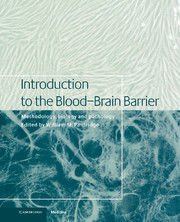Book contents
- Frontmatter
- Contents
- List of contributors
- 1 Blood–brain barrier methodology and biology
- Part I Methodology
- Part II Transport biology
- Part III General aspects of CNS transport
- 27 The blood-CSF barrier and the choroid plexus
- 28 Arachnoid membrane, subarachnoid CSF and pia–glia
- 29 Circumventricular organs of the brain
- 30 Transport in the developing brain
- Part IV Signal transduction/biochemical aspects
- Part V Pathophysiology in disease states
- Index
28 - Arachnoid membrane, subarachnoid CSF and pia–glia
from Part III - General aspects of CNS transport
Published online by Cambridge University Press: 10 December 2009
- Frontmatter
- Contents
- List of contributors
- 1 Blood–brain barrier methodology and biology
- Part I Methodology
- Part II Transport biology
- Part III General aspects of CNS transport
- 27 The blood-CSF barrier and the choroid plexus
- 28 Arachnoid membrane, subarachnoid CSF and pia–glia
- 29 Circumventricular organs of the brain
- 30 Transport in the developing brain
- Part IV Signal transduction/biochemical aspects
- Part V Pathophysiology in disease states
- Index
Summary
Introduction
Well-ordered neuronal activity requires regulated extracellular milieu. To provide such microenvironmental stability for neurons, the bloodbrain and blood–CSF barriers work together to maintain extracellular fluid. Blood–CSF barrier is comprised not only of choroid plexus but also of arachnoid membrane. Choroid and arachnoid cells are intimately associated with ventricular and subarachnoid CSF, respectively, in anatomically ‘interior’ and ‘exterior’ aspects of the brain. Thus, CSF in the ventricles and subarachnoid space contributes substantially to the volume and hydrodynamics of CNS extracellular fluid (Johanson, 1995).
Subarachnoidal CSF, together with the arachnoid and pia mater that enclose it (Fig. 28.1), have been analyzed less than the ventricular CSF with its surrounding choroidal/ependymal cells (Johanson, 1988). However, there has been a recent upswing in interest in the subarachnoid space and its encompassing leptomeninges. Secretion, transport and convective distribution of solutes and water (fluid) throughout the subarachnoid CSF system impacts CNS pharmacokinetics (Bacher et al., 1994), the spread of infections, neuroimmunologic phenomena, edema resolution (Groger et al., 1994), bleedings, and metastases/chemotherapy. Bulk flow of substances in subarachnoid CSF also contributes to modulation of brain development.
The paucity of literature reviews on functional aspects of subarachnoid CSF and leptomeninges reflects limited research in this area.
- Type
- Chapter
- Information
- Introduction to the Blood-Brain BarrierMethodology, Biology and Pathology, pp. 259 - 269Publisher: Cambridge University PressPrint publication year: 1998
- 4
- Cited by



